Joy Neal Kidney's Blog, page 75
February 5, 2021
Two Nights in Grand Island
We had no children yet in 1973, so Guy still enjoyed driving his second hand 1966 Corvette to work at Stapleton Tower in Denver. Our other car was a 1969 VW bug, which someone was borrowing while we brought the Vette back to Iowa for a vacation.

We were to arrive late on Guy’s mother’s birthday, but Nebraska is a very wide state. The clutch went out near Grand Island so we were towed to there, but they needed to order parts which wouldn’t be there until the next day.
A motel was within walking distance, a place to eat, and also a movie theater. We watched “Paper Moon.”
Late the next afternoon we learned that the new parts were defective. The mechanics loaned us a ’63 Chevy with a fur dashboard. There were also fuzzy dice hanging from the rear-view mirror, and we got several gawkers. Probably friends of the guy who owned the car and hadn’t paid for repairs on it.
Since Guy was an air traffic controller, we drove to the Grand Island airport, toured the national weather service and flight service station. We were thankful that the theater changed to a new movie, so we killed time by watching “Badge 373.”
Finally the third day we were able to leave Grand Island early in the afternoon. Guy decided to make up a little time getting to his mother’s, but got pulled over in Iowa by a cop standing next to the highway and flagging over speeder after speeder. We had to sit in line for another trooper to come give us the ticket.
When we finally got to the Glidden farm, two days late for Guy’s mother’s birthday, we figured it would have been quicker and cost us less to just fly home.
But now we have a story to tell.
February 3, 2021
A Survivor’s Story of Four Chaplains Day–the Torpedo Attack on the Troop Ship Dorchester
Over a year ago I reviewed a book about the USAT Dorchester disaster. I discovered that February 3 is a day of remembrance for the four chaplains who lost their lives serving the men on that ship, so I’d already made a meme for today.

Then Monday, this showed up on Instagram: “Happy 100th Birthday in heaven to my Grandfather Michael Calandriello. He served in the Army Air Force during WW2 and was one of few survivors of the torpedo attack on the USAT Dorchester on February 3, 1943.”
I recognized the name of the ship, then noticed the hashtags:
#family #lineage #history #ww2 #grandfather #usatdorchester #angelbirthday #life #love #brooklyn #newjersey #4chaplains #europe #neverforgotten
From the book: “In the early morning hours of February 3, 1943, a German submarine torpedoes the American troop ship Dorchester en route to a top secret radar installation in Greenland. The four Army chaplains on board could scarcely be more different from each other: Methodist pastor and war veteran George Fox; intellectual and athletic Rabbi Alex Goode; scholar, poet, and Dutch Reformed minister Clark Poling; baseball fan and “regular guy” Father John Washington. Yet in the terror and confusion following the attack by a deadly U-boat wolfpack, the chaplains unite in a final triumphant sacrifice that transforms the life of every survivor who lives to tell of it.”
I sent a note to glenn_against_the_machine, acknowledging what he’d posted. He sent photos and more information and gave me permission to share this story of his maternal grandfather, who was one of only 230 survivors out of over 900 on the ship.
“Never remove your left jackets! Eat, sleep and work in them but never ever take them off.” Obeying that order saved the life of Glenn Simmons’ grandfather Michael Calandriello who served in the Army Air Force during WWII.
SSgt. Michael Calandriello’s Story
“The torpedo struck like a giant hand reaching out of the sea and puncturing a hold in the side of the ship. Forward motion stopped, we began a hard sideward skid stirring the dark waters beneath the hull. Moving automatically, I joined my shipmates in making my way across the sloping deck to my assigned station.
“Just like in drills, the lifeboat was loaded and we were lowered over the side. Nothing in our training, however, had prepared us for the shock of the lifeboat tipping and dumping us over, to be engulfed by the frigid water. . . .
“Treading water, I saw a G.I. grab an axe and cut the ropes allowing the lifeboat to right itself. But my hopes were dashed as a desperate man jumped from the deck above, landed in the lifeboat, and crashed through the bottom.
“Yet I was one of the lucky ones.
“Soon another lifeboat came by and picked me up. A Black crewman, Charley Wright, who had already survived previous torpedoings, took charge. With only three oars and all of us bailing furiously, we managed to stay afloat until we were rescued by the Coast Guard Cutter Escanaba.
“. . . Along the rails of all three decks [of the Dorchester] was an unbroken line of men. All were to paralyzed by fear to jump. I shouted ‘Get off! Get off!’ but the turmoil drowned my voice. . .
“I was among the first picked up. The courageous men of the Escanaba stripped off my clothes, wrapped me in blankets and began rubbing my frozen legs. For hours men were carried in, oil-slicked, unconscious, some dying and some who would be dead by morning’s first light.
The Four Chaplains
“It was from those picked up last that I first heard the story of the Four Chaplains. I had known Father Washington from Mass and confession. I remember his soft-spoken caring. There was an underlying strength to the man that reassured us he would always do God’s work and take care of his men no matter what happened. That’s exactly what he and his fellow chaplains did that fateful night.
We spoke not a word
“Almost fifty years have passed, yet the visions of that night remain vivid in my mind. One man in particular stands out. He was a Jewish buddy who pulled me into the lifeboat and rubbed life back into my limbs on board the Escanaba. As he held his prayer book and I held my rosary beads, we spoke not word. But in our hearts we knew our faith in our common God had spared us.
“This was akin to the example set by the Four Chaplains. Though their lives were not spared, they had helped to spare others and bring comfort to those doomed to perish. Four men, three faiths, one God–this is their legacy. What better monument than t have etched into our minds and hearts the sight of these four men of God staying with their flock, giving them strength and faith as they entered eternal rest.”
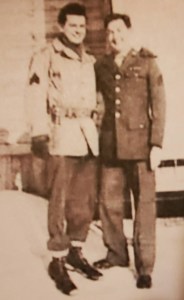
Michael Calandriello (left) and his friend John Fisher. Believed to have been taken in Greenland shortly after the sinking of the Dorchester.
Thanks to Glenn A. Simmons (on the right), who served as marine infantryman during the Global War on Terror. His father, Glenn D. Simmons (left) served with 10th special forces in Vietnam.

A Survivor’s Story of the Torpedo Attack on the Troop Ship Dorchester
Over a year ago I reviewed a book about the USAT Dorchester disaster. I discovered that February 3 is a day of remembrance for the four chaplains who lost their lives serving the men on that ship, so I’d already made a meme for today.

Then Monday, this showed up on Instagram: “Happy 100th Birthday in heaven to my Grandfather Michael Calandriello. He served in the Army Air Force during WW2 and was one of few survivors of the torpedo attack on the USAT Dorchester on February 3, 1943.”
I recognized the name of the ship, then noticed the hashtags:
#family #lineage #history #ww2 #grandfather #usatdorchester #angelbirthday #life #love #brooklyn #newjersey #4chaplains #europe #neverforgotten
From the book: “In the early morning hours of February 3, 1943, a German submarine torpedoes the American troop ship Dorchester en route to a top secret radar installation in Greenland. The four Army chaplains on board could scarcely be more different from each other: Methodist pastor and war veteran George Fox; intellectual and athletic Rabbi Alex Goode; scholar, poet, and Dutch Reformed minister Clark Poling; baseball fan and “regular guy” Father John Washington. Yet in the terror and confusion following the attack by a deadly U-boat wolfpack, the chaplains unite in a final triumphant sacrifice that transforms the life of every survivor who lives to tell of it.”
I sent a note to glenn_against_the_machine, acknowledging what he’d posted. He sent photos and more information and gave me permission to share this story of his maternal grandfather, who was one of only 230 survivors out of over 900 on the ship.
“Never remove your left jackets! Eat, sleep and work in them but never ever take them off.” Obeying that order saved the life of Glenn Simmons’ grandfather Michael Calandriello who served in the Army Air Force during WWII.
SSgt. Michael Calandriello’s Story
“The torpedo struck like a giant hand reaching out of the sea and puncturing a hold in the side of the ship. Forward motion stopped, we began a hard sideward skid stirring the dark waters beneath the hull. Moving automatically, I joined my shipmates in making my way across the sloping deck to my assigned station.
“Just like in drills, the lifeboat was loaded and we were lowered over the side. Nothing in our training, however, had prepared us for the shock of the lifeboat tipping and dumping us over, to be engulfed by the frigid water. . . .
“Treading water, I saw a G.I. grab an axe and cut the ropes allowing the lifeboat to right itself. But my hopes were dashed as a desperate man jumped from the deck above, landed in the lifeboat, and crashed through the bottom.
“Yet I was one of the lucky ones.
“Soon another lifeboat came by and picked me up. A Black crewman, Charley Wright, who had already survived previous torpedoings, took charge. With only three oars and all of us bailing furiously, we managed to stay afloat until we were rescued by the Coast Guard Cutter Escanaba.
“. . . Along the rails of all three decks [of the Dorchester] was an unbroken line of men. All were to paralyzed by fear to jump. I shouted ‘Get off! Get off!’ but the turmoil drowned my voice. . .
“I was among the first picked up. The courageous men of the Escanaba stripped off my clothes, wrapped me in blankets and began rubbing my frozen legs. For hours men were carried in, oil-slicked, unconscious, some dying and some who would be dead by morning’s first light.
The Four Chaplains
“It was from those picked up last that I first heard the story of the Four Chaplains. I had known Father Washington from Mass and confession. I remember his soft-spoken caring. There was an underlying strength to the man that reassured us he would always do God’s work and take care of his men no matter what happened. That’s exactly what he and his fellow chaplains did that fateful night.
We spoke not a word
“Almost fifty years have passed, yet the visions of that night remain vivid in my mind. One man in particular stands out. He was a Jewish buddy who pulled me into the lifeboat and rubbed life back into my limbs on board the Escanaba. As he held his prayer book and I held my rosary beads, we spoke not word. But in our hearts we knew our faith in our common God had spared us.
“This was akin to the example set by the Four Chaplains. Though their lives were not spared, they had helped to spare others and bring comfort to those doomed to perish. Four men, three faiths, one God–this is their legacy. What better monument than t have etched into our minds and hearts the sight of these four men of God staying with their flock, giving them strength and faith as they entered eternal rest.”

Michael Calandriello (left) and his friend John Fisher. Believed to have been taken in Greenland shortly after the sinking of the Dorchester.
Thanks to Glenn A. Simmons (on the right), who served as marine infantryman during the Global War on Terror. His father, Glenn D. Simmons (left) served with 10th special forces in Vietnam.

February 1, 2021
Odd Fellows Lodge by Bryon Weesner, Dexter Historian
The Independent Order of Odd Fellows Lodge was important to the growth of Dexter’s business district in the late 1800 and early 1900s.
A very active group made up of men from various trades, they were instrumental in the building of the Odd Fellows building on Marshall Street. (The lodge was on the top floor and the bottom floor was shop space–at one time Downey’s and later Adkins Foods).
This is a reversible ribbon badge that would have been worn by members in the early 1900s. The colorful side was worn during IOOF rituals and meetings and the “mourning side” was worn facing out during funerals and in the month of November and December when the lodge recognized the passing of members from that year.
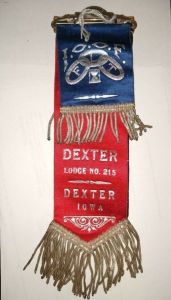
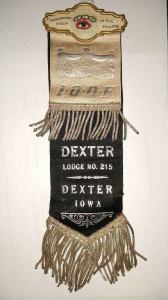
The letters FLT in the Odd Fellows logo represents the cornerstones of Friendship, Love and Truth.
My great grandfather M. S. “Sherd” Goff had been a member of the I.O.O.F. Lodge at Guthrie Center, Iowa, for 27 years. He undoubtedly attended meetings at Dexter when they lived there from 1924-his death in 1930. But he already had a burial plot in Guthrie Center, so after his funeral in Dexter, interment was made in the Guthrie Center cemetery.
The Guthrie Center I.O.O.F. was in charge of the graveside service. Now I can picture that they were wearing their badges with the black side showing.

January 29, 2021
Who were the Rebekahs?
Laura Goff was a member of the Rebekahs.
The Daughters of Rebekah, also known as the Rebekahs and the International Association of Rebekah Assemblies, is an international service-oriented organization and a branch of the Independent Order of Odd Fellows. Laura’s husband “Sherd” Goff was a member of the I.O.O.F.Symbol: Three-link chain, dove, lily, moon and seven stars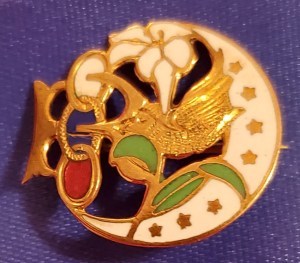 Founder: Schuyler ColfaxFounded: 1851Parent organization: Independent Order of Odd Fellows
Founder: Schuyler ColfaxFounded: 1851Parent organization: Independent Order of Odd FellowsRebekah Creed
I AM A REBEKAH:
I believe in the Fatherhood of God, the Brotherhood of man, and the Sisterhood of woman.
I believe in the watch-words of our Order – Friendship, Love and Truth.
Friendship – is like a golden chain that ties our hearts together. Love – is one of our most precious gifts, the more you give, the more you receive. Truth – is the standard by which we value people. It is the foundation of our society.
I believe that my main concern should be my God, my family and my friends. Then I should reach out to my community and the World, for in God’s eyes we are all brothers and sisters.
I AM A REBEKAH!
Earliest membership card Laura saved was when Goffs lived at Dexter. She paid $1.00 dues to the Eva Ann Rebekah Lodge No. 197 I.O.O.F of Dexter Jurisdiction of Iowa on May 10, 1926. Good until May 1, 1927.

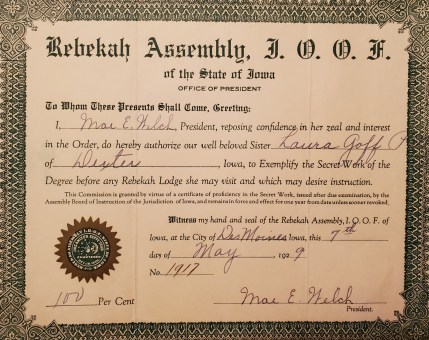
It’s interesting that even after Laura moved to Omaha with her sons, she still kept up her membership in Dexter.
After World War II, when her daughter Leora lost three sons and was widowed, they moved Guthrie Center to live together. Guthrie County was where both were born, grew up, and still knew and were related to so many people there. Laura transferred her membership to the Mizpah Rebekah Lodge, No. 92, at Guthrie Center. May 17, 1948. She’s listed as a Past Noble Grand.
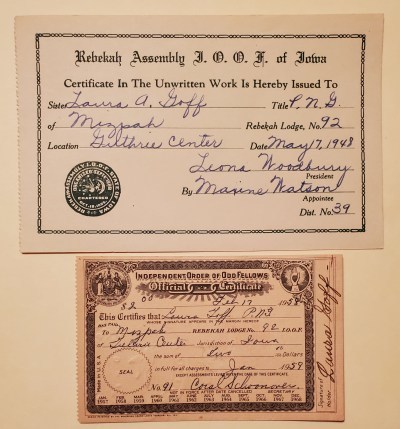
Her daughter Leora also joined the Rebekahs at Guthrie Center. I remember attending a meeting as a child. Grandma Leora wore a long white dress and during the meeting, the ladies kind of did a sedate square dance. At least that’s how it seemed to a young girl.
I know that they regularly patched and sewed at the Guthrie County Hospital.
—–
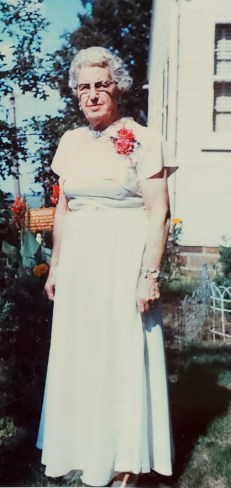 “Leora Goff Wilson Aug. 12, 1968
“Leora Goff Wilson Aug. 12, 1968
“Donald took picture on Polaroid Camera
“Guthrie Center Iowa”
Must have been a special meeting for her to be wearing a corsage.
A small bell charm dangles from her watch. It’s the souvenir bell from Capri that her fourth son Danny Wilson bought when he first got to Italy for combat.
January 27, 2021
Roller Skating in the House (poem)
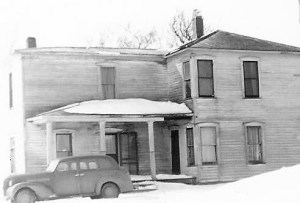
Roller Skating in the House
The lumbering Iowa farmhouse had a back roomwith downhill linoleum to roller skate on,a cob-burning stove, where my mothersewed up baby pigs, stepped on by mother sows.A cubbyhole under the stairs,a musty mousy smell,where Dad kept his watch and billfoldand unfiltered Camels.A front room, closed off in winter,a locked room upstairs where Momkept her hope chest of high school mementos,her aqua formal gown, Dad’s Air Corps uniform.A big front porch, where we watched,wrapped in stove-warmed blankets, for Sputnik,before Dad tore down my castle to buildmy mother a small green mouse-free house. 2005
2005
January 25, 2021
January 1946
The New Year of 1946 brought devastating news to Clabe and Leora Wilson.Their oldest son Delbert and his family, including toddler Leora Darlene and baby Donna, were living with them then in the little house south of Perry.
From the Adjutant General’s Office in the War Department, Washington 25 D.C.
15 January 1946
Dear Mr. and Mrs. Wilson,
Since your son, Second Lieutenant Dale R. Wilson, Air Corps, was reported missing in action 27 November 1943, the War Department has entertained the hope that he survived and that information would be revealed dispelling the uncertainty surrounding his absence. However, as in many cases, the conditions of warfare deny us such information.
Public Law 490, 77th Congress, as amended, provided for a review and determination of the status of each person who has been missing in action for twelve months. Accordingly, your son’s case was reviewed and he was continued in the status of missing in action as of November 1944. The law further provides that a subsequent review shall be made whenever warranted. Upon such subsequent review the making of a finding of death is authorized.
All available records and reports concerning the absence of your son have been carefully investigated and are deemed to warrant a subsequent review of his case. Information in the hands of the War Department indicates that your son was a crew member of a B-25 (Mitchell) bomber which participated in a strike mission to Wewak, New Guinea on 27 November 1943. The plane was hit by enemy anti-aircraft fire and was seen to crash in the water one and a half miles off the shore of Cape Boram, New. Guinea. After crashing into the water, the plane disintegrated, and the wreckage remained afloat but a short time before sinking. Observers from other planes failed to see any survivors emerge from the wreckage.
Since no information has been received which would support a presumption of his continued survival, the War Department must now terminate your son’s absence by a presumptive finding of death. Accordingly, an official finding of death has been recorded. The finding does not establish an actual or probable date of death; however, as required by law, it includes a presumptive date of death for the purpose of termination of pay and allowances, settlement of accounts and payment of death gratuities. In the case of your son, this date has been set as 15 January 1946.
I regret the necessity for this message but trust that the ending of a long period of uncertainty may give at least some small measure of consolation. An appraisal of the sacrifice made by your son in the service of his country compels in us feelings of humility and respect. May Providence grant a measure of relief from the anguish and anxiety you have experienced during these many months.
Edward F. Witsell, Major General, Acting the Adjutant General of the Army
—–
WASHINGTON DC, JAN. 22, 1946 CLABE D. WILSON, MINBURN, IOWA. THE SECRETARY OF WAR HAS ASKED ME TO EXPRESS HIS DEEP REGRET THAT YOUR SON 2ND LT DANIEL S WILSON WAS KILLED IN ACTION OVER AUSTRIA 19 FEBRUARY 1945. HE WAS PREVIOUSLY REPORTED MISSING IN ACTION. I REGRET THAT OFFICIAL REPORT RECEIVED ESTABLISHES HIS DEATH. CONFIRMING FOLLOWS E.F. WITSELL, ACTING ADJUTANT GENERAL
—–
From the Adjutant General’s Office in the War Department, Washington 25, D.C.
23 January 1946
Dear Mr. Wilson,
It is with deep regret that I am writing to confirm the recent telegram informing you of the death of your son, Second Lieutenant Daniel S. Wilson, Air Corps.
Your son was reported missing in action since 19 February 1945 over Austria. It has now been officially established from reports received in the War Department that he was killed in action on 19 February 1945 in an airplane crash in Schwanberg, Deutschlandsberg County, Austria.
I know the sorrow this message has brought you and it is my hope that in time the knowledge of his heroic sacrifice in the service of his country may be of sustaining comfort to you.
I extend to you my deepest sympathy.
Edward F. Witsell, Major General, Acting The Adjutant General of the Army
The Perry Daily Chief
February 6, 1946
Three Brothers Pay Supreme Sacrifice
Mr. and Mrs. Clabe Wilson, who live two miles southeast of Perry, are entitled to have a service flag in their window with five stars on it—three of them gold.
One of the hardest hit local families by the war, Mr. and Mrs. Wilson lost three sons during the recent world conflict. Another son was recently discharged from the navy and a fifth is still in the service.
Flight Officer Claiborne Junior Wilson, 20, youngest son of Mr. and Mrs. Wilson, was killed in a plane accident August 9 last year, at Aloe Field, Victoria, Texas.
Word has been received from the War Department that Lt. Dale R. Wilson, 24, who has been reported missing in action since Nov. 27, 1943, is now presumed dead. He was on a mission to New Guinea. [Dale was 22 when his plane was shot down.]
Dale received his wings at Roswell, New Mexico in Feb. 1943 and left for overseas in July of the same year. He served with the Fifth Air Force and was stationed at Port Moresby, New Guinea.
The War Department has notified the Wilsons that their son. Lt. Daniel S. Wilson, 22, who was previously reported as missing in action Feb. 19, 1945, is now reported killed in action on that date in a plane crash over Schwanberg, Austria. [Dan was 21.]
Daniel received his wings at Williams Field, Chandler, Arizona. He left for overseas in Oct. 1944 and was based with the 15th Air Force in Italy.
Two other sons of Mr. and Mrs. Wilson also served with the armed forces.
Delbert Wilson, 30, who had the rating of electrician’s mate first class in the navy, is now home discharged after being in the service four years. Previous to his second enlistment he had served in the navy four years.
Chief Electrician Donald Wilson, 29, who has been in the navy 12 years, is now stationed in Seattle, Wash.

The Wilson brothers are featured on the Dallas County Freedom Rock at Minburn, Iowa. All five served. Only two came home. Their story is told in Leora’s Letters: The Story of Love and Loss for an Iowa Family During World War II.
January 23, 2021
Grandma Ruby’s Cactus

At Grandma Ruby’s home on the farm, you never used the front door. Everyone was drawn to the back door, even salesmen.
The back of the white frame house was cozy and inviting. Plants, large and small, a porch swing painted white, a brick patio that she herself had laid. I can imagine her–stooping over in her homemade print dress, tan lisle stockings, and sensible black shoes–arranging the bricks on a bed of sand. In spite of her ample girth, she always bent straight over rather than stooping.
 Kenneth and Ruby Neal, near the brick patio
Kenneth and Ruby Neal, near the brick patioWhen you knocked at the back door, Grandma’s falsetto echoed from the kitchen, “Come in!” She’d greet you, wiping her hands on her cross-stitched apron. Mornings you’d catch her kneading bread dough or baking a pie or thickening a batch of apple butter. Afternoons, as likely as not, she’d be stitching on a quilt–Double Wedding Ring, Grandmother’s Flower Garden, and Dahlia Star Flower being favorites–using scraps from sewing dresses and aprons and curtains and work shirts.
Once a salesman came to the back door. He noticed a large cactus in a clay pot on the patio. Taller than it was round, it had a flock of little prickly bumps clinging to it, especially around its base. It reminded you of a mother hen with its chicks.
“That’s a mighty nice plant there,” he opened the conversation. “What is it?”
“Oh, mercy. It’s just a cactus.” Ruby chuckled, adjusting her wire rimmed glasses.
“You wouldn’t sell it, would you?”
“Oh, my.” She absently pushed a wavy brown hairpin into the gray strands that were wound around her head.
“How much would you take for it?”
She had other cacti started–plucked from the mother plant, growing in their own pots. “Oh, a dollar.”
The salesman was pleased with his bargain. And Grandma was pleased with hers.
I ended up with one of these heirlooms, which traveled with us from state to state. For years it spent summers on our patio made (not by me) from Redfield Pavers. It spent winters in the basement, just like Grandma’s used to. I’d start cactus chicks in their own pots, just like she did. I wish I still had one, descended from Grandma Ruby’s from the farm.
Ruby Blohm was my only grandparent to earn a high school diploma. Dexter High School 1916. She was also my first ancestor to play basketball in high school!
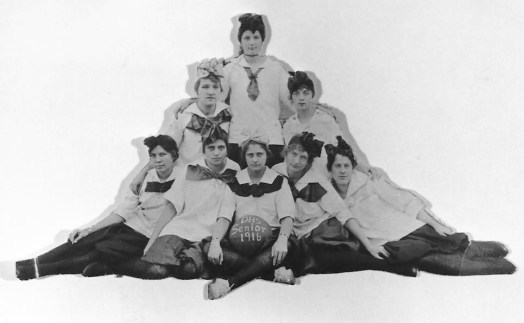 Ruby Blohm is in the center with the basketball.
Ruby Blohm is in the center with the basketball.
January 22, 2021
Grandma’s Apron: Guest Blogger Grandma Ruby (Blohm) Neal
Grandma’s Apron
by Ruby Blohm Neal
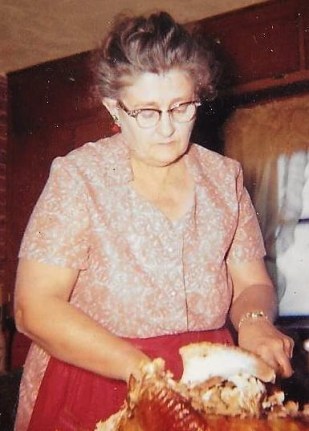 Grandma Ruby Neal wearing festive earrings and apron, and working on a turkey, rural Dexter, Iowa
Grandma Ruby Neal wearing festive earrings and apron, and working on a turkey, rural Dexter, IowaGrandmothers always used to wear aprons; they were a matter of necessity. An apron was made from an arm’s length of material, hemmed and gathered at the waist with a band and ties. Most were checks or prints because they didn’t show soil as easy. Some were fancy with cross-stitch or embroidery.

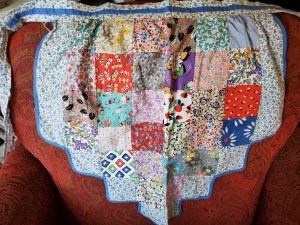


The apron had many uses. When Grandma was in the garden it was gathered up and used as a basket. In the yard it would be used to told a chow chip or so for the fire, a few eggs the old hens had hidden, and a bunch of wild flowers for the table.

It was used to dry many a tear from a crying child or wipe a dripping nose. The apron shooed many flies at the door and removed pans of bread or sheets of cookies from the oven. It served as a pad to take hold of hot pans on the stove or poke the coals; it then wiped the sweat from the brow. When Grandma was out in the meadow to meditate and give thanks, her thoughts would be interrupted by spotting a new calf and trying to get it home in her apron.
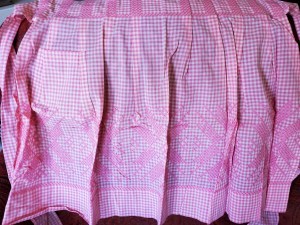
These aprons were easier to wash than a dress and could be changed in a moment’s notice. When a visitor was seen coming, it was quickly removed. the apron hastily dusted the table and polished the silver. It was used to cover the head and take the chill from the shoulders. Carrying wash water to the house and out again, the apron invariably fell in the pail of water a few times. At canning time the corner was used to hold the jar while screwing on the zinc lid.
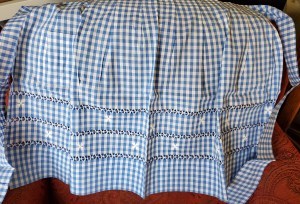
At last, when the apron was worn thin from many washings, it was cut into strips to be braided and sewed together to make a rug to adorn the floor by the bed or a favorite chair. Narrower strips were sewed and rolled into balls and taken to a person who had a loom to weave rugs.
I’ll bet that most of the aprons above were made by Grandma Ruby Neal. I know she did the cross-stitch ones.
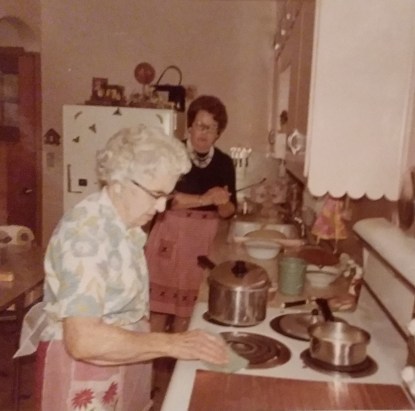
Leora Wilson and daughter Doris Neal, wearing one of Ruby Neal’s creative aprons, Guthrie Center, 1970s.
January 20, 2021
Don’t Let Those Precious Notes get Thrown Away!
After my fling with genealogy and making sure all the relatives had copies of them and the transcribed memoirs of grandmothers, I became a Den mother and school and church volunteer.
Genealogy got left behind.
But after Dan was in school every day, I spent time with my widowed mother. She still lived on the Madison County farm where I grew up, but we usually went somewhere, even if it was just taking a drive into Guthrie County. She’d tell stories of her growing up years in Dexter. I began to take notes, and learned to ask which house she lived in during which episode. Sometimes we’d drive by those houses in Stuart and Dexter. I’m thankful we did, since only one of them still stands.
House after house! Sometimes stories would emerge when someone else was driving. I’d be in the back seat scribbling notes on a scrap of paper.
Most of the stories weren’t new. I’d heard Mom tell them all my life. Well, I didn’t exactly hear them, as I’d pretty well shut them out. But here she was, putting flesh on those family trees, adding color to her own mother’s memoirs.
All of a sudden they’d become fascinating.
Mom, abetting me, scrolled through microfilms of old newspapers at the Iowa State Historical Library, where we’d make copies of clippings. Then we’d have pizza at Noah’s Ark on Ingersoll Avenue on the way home.
I began to sort them into file folders, house by house. After reading all the World War II letters and all the research about the brothers, I added a third four-drawer filing cabinet.

Then I read that if your notes are on backs of envelopes and scribbled on napkins, your descendants will toss all of them. No!
But I knew that’s exactly what would happen.
A couple of years ago I began typing up the notes chronologically and merging them with clippings, letters, postcards, significant dates. They are now safely in notebooks, which I’m pretty sure our son would at least take home before summarily tossing them. And by then, he just might find them fascinating.
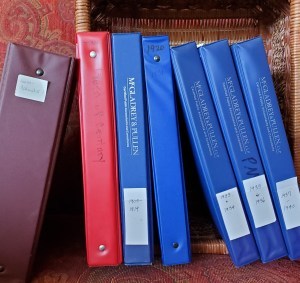
The information in them have made old photos come to life, and have been so helpful as I’m sculpting the second of what will eventually turn into a trilogy of “Leora stories.” Leora was my mother’s mother, my delightful Grandma Leora.
The moral to this story is: Write down your stories, type up any that look like they probably should be recycled, label those old photos!
You’ll be so glad you did.



